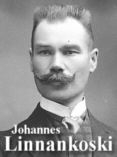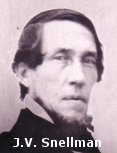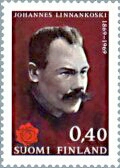The Association of Finnish Culture and Identity, also known as
the Finnish Alliance, is a Finnish cultural organization.
The official name of the Association is
in Finnish Suomalaisuuden liitto,
in German Verband für Finnentum e. V. and
in French La Ligue Finlandaise.

|
The Finnish Alliance was founded by writer Johannes Linnankoski in 1906.
The founding date was the 100th anniversary of J.V. Snellman,
a prominent national Finnish philosopher and statesman.
The purpose was and is still today to awaken and to strengthen the sense of
national identity, to promote Finnish education and culture.
A significant goal is to cultivate the Finnish language.
|

|
One of the most far-reaching manifestations of the Finnish Alliance's activities
was the mass fennification of family names in 1906-07.
This was repeated in 1935-36 with the result of
more than 200,000 people changing their family names into Finnish.
The Association of Finnish Culture and Identity
has played a remarkable role in Finnish cultural life. It
provided the initiatives which led to the creation of
the Fund for the Promotion of Finnish Literature
(Suomen kulttuurirahasto),
Suomi-Seura (an organization to unite the Finns abroad),
and the Finnish Family Planning Association (Väestöliitto).
|
The President of the Finnish Alliance in 1930-32 was Urho Kekkonen,
the President of Finland in 1956-81.
The Finnish Alliance is an important element in the Finnish
establishment. It provides expert advice on matters such as the displaying of
the Finnish flag and Finnish family names.
It creates and maintains contacts between Finland and Finns living abroad.
The Association of Finnish Culture and Identity
especially emphasizes Finnish pupils' and students' right to determine
for themselves the foreign languages they wish to study.
In addition the Association of Finnish Culture and Identity
pursues research, publishes books, sells Finnish flags made in Finland,
gives talks and lectures and is involved in many other activities in its goal
to strengthen the Finnish identity.
For further information,
please contact us. Our address is:
Suomalaisuuden liitto ry
Aurorankatu 7 A 1
00100 HELSINKI
|
Telephone +358-9-442 824 (in Finland 09-442 824)
Fax +358-9-496 871 (in Finland 09-496 871)
E-mail 
|
WARNING: A hostile office, probably Swedish, forges e-mails as if the mails were sent
by us. The Finnish Alliance has not sent them and is not responsible for them.
A bogus can be identified by its inconsistency with the main
guidelines of the Finnish Alliance.

|

|
Johannes Linnankoski,
the founder of the Finnish Alliance, in the Finnish stamp of 1969
|
Famous Finns
The Finns below all have Finnish roots.
J.V. Snellman, a statesman and philosopher,
and
Elias Lönnrot, the creator
of
Kalevala are the main national Finnish figures
in the 19th century.
The world-famous
composer
Jean Sibelius' works include strongly nationalistic symphonic
poems such as
Finlandia in 1900.
Sibelius' family originally came from Artjärvi in Eastern Uusimaa.
He went to Hämeenlinna Lyseo, a highly esteemed Finnish grammar school
in the heart of Finnish speaking Häme.
Albert Edelfelt was a famous painter,
who worked primarily in France.
His famous protrait of Louis Pasteur hangs
in the Musée d'Orsay in Paris.
The element Gadolinium was
named after Finnish chemist Johan Gadolin, whose original Finnish
last name was Isolin.
Under Swedish rule
Gadolin's family, as well as many others, in the 17th and 18th century had to give up their original
Finnish family names in order to obtain an education.
This was a period when Finnish names were Swedenized,
Germanized and Latinized and in Gadolin's
case, translated into Hebrew with a suffix in or lin.
Gad in Hebrew means big, just as Finnish iso.
The distinguishing feature of Latinized names is -us or -ius, as in Chydenius.
Antti Chydenius, an economist, presented the principles of the free trade before
Adam Smith. Antti Chydenius was a priest in Kokkola.
Unfortunately for him communication was not effective in the 18th
century, so his ideas did not spread abroad.
Famous Finns in America and early explorers
John Morton was a descendant of
the Finns who settled in Delaware in the 17th century; his original Finnish name
was
Marttinen and his family
came from the county of
Rautalampi in Central Finland.
John Morton was
one of the signers of the Declaration of Independence
of the United States.
Eero Saarinen
and his father
Eliel Saarinen were famous Finnish American architects.
Pietari (Pehr) Kalm was a Finnish explorer and botanist,
who wrote the first description of the Niagara Falls.
The explorer A.E. Nordenskiöld was born in Helsinki, Finland. He
was sympathetic to Finnish nationalistic concepts and
was therefore
expelled from Finland by the Tsarist governor of Finland.
He was the first to navigate the Northeast Passage.
A descendant of the Finns who moved to
Taalainmaa region in Central Sweden in the 17th century was Dan(iel)
Andersson, later to became the national poet of Sweden.
The most famous of the Finnish Orientalists, Yrjö (George) Wallin,
traveled around Arabian Peninsula in the 19th century. His memoir is a classic for the Orientalists.
He was later awarded a medal by the Royal Geographic Society.
Väinö Auer explored
the southermost part of South America.
Paavo Nurmi is the greatest runner of all times.

